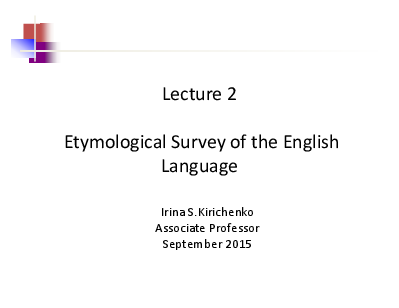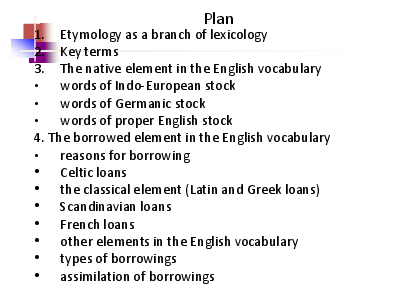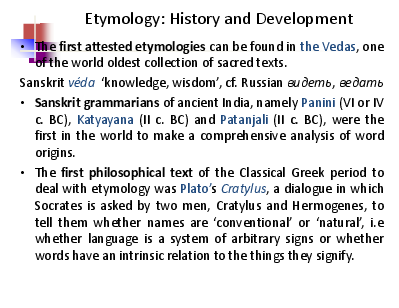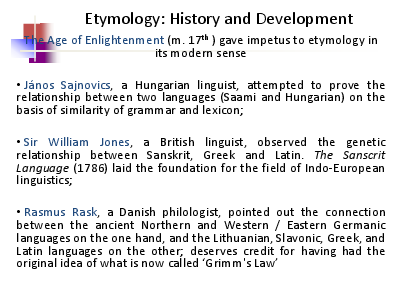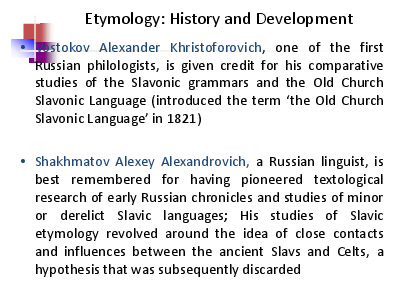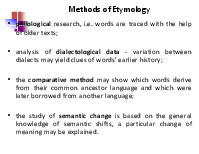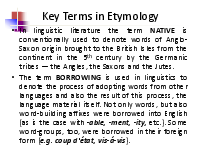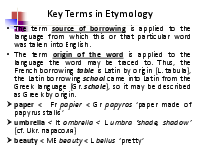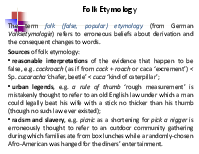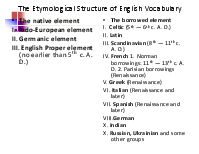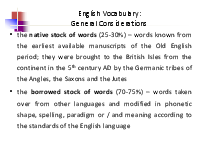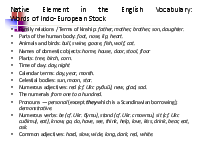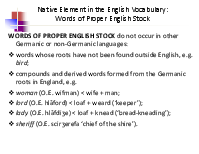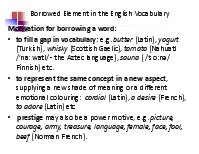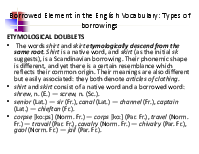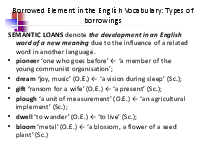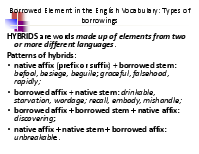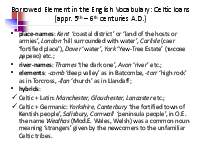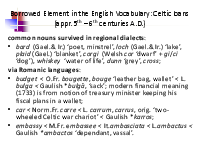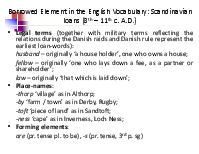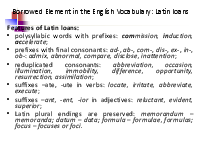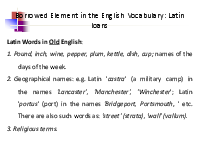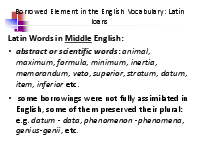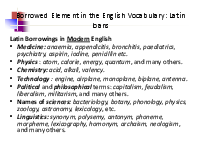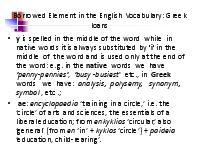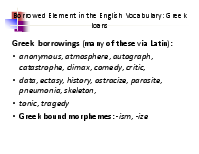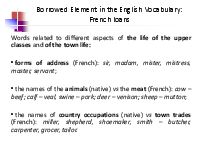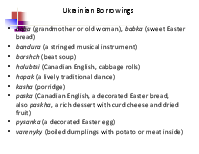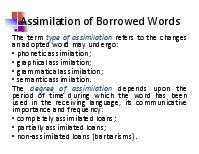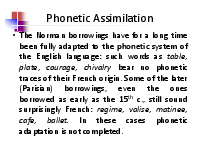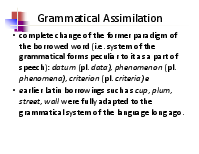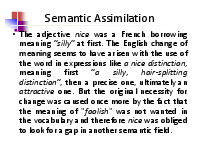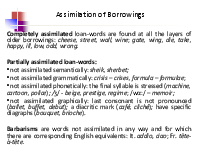Lecture 2 Etymological Survey of the English Language
Irina S.Kirichenko
Associate Professor
September 2015
Plan
-
Etymology as a branch of lexicology
-
Key terms
-
The native element in the English vocabulary
-
words of Indo-European stock
-
words of Germanic stock
-
words of proper English stock
-
4. The borrowed element in the English vocabulary
-
reasons for borrowing
-
Celtic loans
-
the classical element (Latin and Greek loans)
-
Scandinavian loans
-
French loans
-
other elements in the English vocabulary
-
types of borrowings
-
assimilation of borrowings
Etymology: History and Development
-
The first attested etymologies can be found in the Vedas, one of the world oldest collection of sacred texts.
-
Sanskrit véda ‘knowledge, wisdom’, cf. Russian видеть, ведать
-
Sanskrit grammarians of ancient India, namely Panini (VI or IV c. BC), Katyayana (II c. BC) and Patanjali (II c. BC), were the first in the world to make a comprehensive analysis of word origins.
-
The first philosophical text of the Classical Greek period to deal with etymology was Plato’s Cratylus, a dialogue in which Socrates is asked by two men, Cratylus and Hermogenes, to tell them whether names are ‘conventional’ or ‘natural’, i.e whether language is a system of arbitrary signs or whether words have an intrinsic relation to the things they signify.
Etymology: History and Development
-
The Age of Enlightenment (m. 17th ) gave impetus to etymology in its modern sense
-
János Sajnovics, a Hungarian linguist, attempted to prove the relationship between two languages (Saami and Hungarian) on the basis of similarity of grammar and lexicon;
-
Sir William Jones, a British linguist, observed the genetic relationship between Sanskrit, Greek and Latin. The Sanscrit Language (1786) laid the foundation for the field of Indo-European linguistics;
-
Rasmus Rask, a Danish philologist, pointed out the connection between the ancient Northern and Western / Eastern Germanic languages on the one hand, and the Lithuanian, Slavonic, Greek, and Latin languages on the other; deserves credit for having had the original idea of what is now called ‘Grimm's Law’
Etymology: History and Development
-
Vostokov Alexander Khristoforovich, one of the first Russian philologists, is given credit for his comparative studies of the Slavonic grammars and the Old Church Slavonic Language (introduced the term ‘the Old Church Slavonic Language’ in 1821)
-
Shakhmatov Alexey Alexandrovich, a Russian linguist, is best remembered for having pioneered textological research of early Russian chronicles and studies of minor or derelict Slavic languages; His studies of Slavic etymology revolved around the idea of close contacts and influences between the ancient Slavs and Celts, a hypothesis that was subsequently discarded
Achievements in English Etymology
-
Walter Skeat’s Etymological English Dictionary in 4 parts
-
(1879-1882; rev, and enlarged, 1910)
-
C. T. Onions, G. W. S. Friedrichsen, R. W. Burchfield
-
Oxford Dictionary of English Etymology
-
(1966, reprinted 1992, 1994)
-
J. Donald Chambers's Etymological Dictionary of the English Language (last ed. 2001)
-
Online Etymology Dictionary www.etymonline.com
Methods of Etymology
-
philological research, i.e. words are traced with the help of older texts;
-
analysis of dialectological data - variation between dialects may yield clues of words’ earlier history;
-
the comparative method may show which words derive from their common ancestor language and which were later borrowed from another language;
-
the study of semantic change is based on the general knowledge of semantic shifts, a particular change of meaning may be explained.
Key Terms in Etymology
-
In linguistic literature the term NATIVE is conventionally used to denote words of Anglo-Saxon origin brought to the British Isles from the continent in the 5th century by the Germanic tribes — the Angles, the Saxons and the Jutes.
-
The term BORROWING is used in linguistics to denote the process of adopting words from other languages and also the result of this process, the language material itself. Not only words, but also word-building affixes were borrowed into English (as is the case with -able, -ment, -ity, etc.). Some word-groups, too, were borrowed in their foreign form (e.g. coup d'état, vis-á-vis).
Key Terms in Etymology
-
The term source of borrowing is applied to the language from which this or that particular word was taken into English.
-
The term origin of the word is applied to the language the word may be traced to. Thus, the French borrowing table is Latin by origin (L. tabula), the Latin borrowing school came into Latin from the Greek language (Gr. schole), so it may be described as Greek by origin.
-
paper < Fr papier < Gr papyros ‘paper made of papyrus stalks’
-
umbrella < It ombrella < L umbra ‘shade, shadow’ (cf. Ukr. парасоля)
-
beauty < ME beauty < L bellus ‘pretty’
Folk Etymology
-
The term folk (false, popular) etymology (from German Volksetymologie) refers to erroneous beliefs about derivation and the consequent changes to words.
-
Sources of folk etymology:
-
reasonable interpretations of the evidence that happen to be false, e.g. cockroach (as if from cock + roach or caca ‘excrement’) < Sp. cucaracha ‘chafer, beetle’ < cuca ‘kind of caterpillar’;
-
urban legends, e.g. a rule of thumb ‘rough measurement’ is mistakenly thought to refer to an old English law under which a man could legally beat his wife with a stick no thicker than his thumb (though no such law ever existed);
-
racism and slavery, e.g. picnic as a shortening for pick a nigger is erroneously thought to refer to an outdoor community gathering during which families ate from box lunches while a randomly-chosen Afro-American was hanged for the diners’ entertainment.
The Etymological Structure of English Vocabulary
-
The native element
-
I. Indo-European element
-
II. Germanic element
-
III. English Proper element (no earlier than 5th c. A. D.)
-
The borrowed element
-
I. Celtic (5th — 6th c. A. D.)
-
II. Latin
-
III. Scandinavian (8th — 11th c. A. D.)
-
IV. French 1. Norman borrowings: 11th — 13th c. A. D. 2. Parisian borrowings (Renaissance)
-
V. Greek (Renaissance)
-
VI. Italian (Renaissance and later)
-
VII. Spanish (Renaissance and later)
-
VIII.German
-
X. Indian
-
X. Russian, Ukrainian and some other groups
English Vocabulary: General Considerations
-
the native stock of words (25-30%) – words known from the earliest available manuscripts of the Old English period; they were brought to the British Isles from the continent in the 5th century AD by the Germanic tribes of the Angles, the Saxons and the Jutes
-
the borrowed stock of words (70-75%) – words taken over from other
